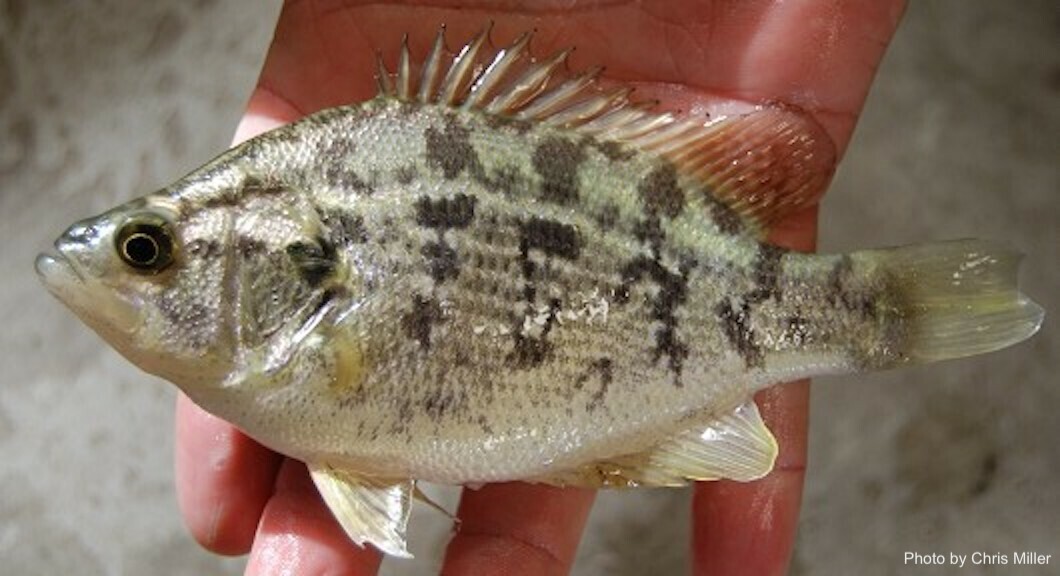
Your Source for Outdoor Adventure
Northern California and Southern Oregon
Helping Sacramento Perch Persist: Genetic Analysis Of The West’s Only Native Sunfish

by FISHBIO
2-7-2022
The popular historical fisheries management practice of transplanting fish from one location to another wreaked ecological havoc in California, but in the case of the imperilled Sacramento perch (Archoplites interruptus) may actually have been a lifeline. Today the species only exists in places where it was introduced, having been completely extirpated from its native range. Unfortunately, those fish movers of the past were far more interested in transplanting fish than in keeping records on said transplantation. This has made some modern fish populations a puzzle of mixed-up genetics, which must be solved to inform species management plans. Untangling the genetic history of the remaining Sacramento perch populations is critical for informing management actions to ensure the species persists into the future. To help build a road map for conservation efforts, researchers from UC Davis and the California Department of Fish and Wildlife undertook a genetic analysis of Sacramento perch from throughout their present-day range (Coen et al. 2021). Their findings published in the journal Transactions of the American Fisheries Society revealed a significant genetic split among perch collected in different locations, indicating a potential difference in ancestry that may be a critical consideration when trying to increase the genetic diversity of the small, isolated populations that exist today.
Sunfish and black basses belong to a family of fish known as Centrarchids. Nearly all the diversity in this North American family was historically found on the eastern half of the continent prior to extensive translocation of species like bluegill (Lepomis macrochirus) and largemouth bass (Micropterus salmoides) to create new fishing opportunities. The Sacramento perch was the sole Centrarchid native to the West Coast of the United States, and was historically abundant in rivers, sloughs, and floodplains of the Sacramento-San Joaquin Delta, as well as the Salinas and Pajaro rivers on the Central Coast, and Clear Lake in the Sacramento Basin. Today, Sacramento perch are not found in any of these watersheds, having been driven locally extinct by 1975 due to overfishing, human alteration of the watershed, and competition and predation by invasive Centrachids. However, the perch’s popularity as a sportfish may have helped save it from extinction, as several populations were established throughout the western United States to create new fisheries. Record keeping on these introduction efforts was sparse, and there is a great deal of uncertainty about where the fish originally came from.
Fortunately, DNA is a better record keeper than humans. To leverage the information stored in the genetic material of Sacramento perch, the researchers analyzed variation at multiple genetic markers from over three hundred fish sampled from eight previously unstudied populations throughout northern California. The sampling locations complemented the sites included in an earlier study, allowing for an assessment of genetics across the entire current range of the species. All of the assessed populations were found to be genetically distinct from one another, and all were marked by low levels of genetic diversity, likely arising from small founding populations followed by many generations in isolation. However, two main clusters became apparent, which likely reflect historic stocking events that used fish from different source populations. This pattern of divergence is significant for management because it may represent source populations that had evolutionarily diverged over a very long time. For example, Sacramento perch in the Delta had been naturally isolated from those in the Salinas and Pajaro rivers for an estimated 600,000 years prior to their extirpation. Therefore, if fish were stocked from these disparate sources, it would be important to consider them as distinct genetic management units.
Populations created through translocation events are typically low in genetic diversity compared to source populations, and the low diversity of today’s Sacramento perch populations likely reflects this. However, their isolation in a scattering of separate ponds, streams, and reservoirs means that individuals cannot migrate from one population to another to maintain genetic diversity or replenish a population following a collapse, which puts the species as a whole at greater risk of extinction. To address this, the researchers advocate for mimicking natural connectivity by strategically translocating individuals from one population to another, thereby reducing the loss of genetic diversity. Such actions require careful planning, but can significantly enhance the ability of a species to persist. However, their detection of a potential ancient divergence in the species led the researchers to caution that translocations should only be conducted among Sacramento perch populations within a given cluster of genetic diversity, at least until this differentiation is better understood. The legacy of this unique Centrarchid demonstrates both the potential value and risks associated with translocation as a tool for management.
FISHBIO is a dedicated group of research scientists, engineers, and technicians that specialize in counting, tracking, and analyzing trends in fish and wildlife populations throughout the world. An expert staff, technical capacity, and state-of-the-art equipment make FISHBIO a trailblazer in aquatic research. For more information, please visit FISHBIO.com
MyOutdoorBuddy.com © 2024. All Rights Reserved.
Website Hosting and Design provided by TECK.net
Website Hosting and Design provided by TECK.net